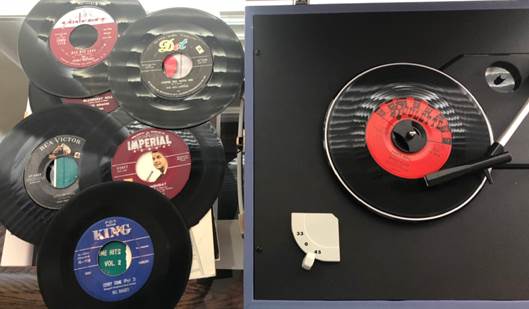The key nostalgic note about the 2018 World Series has been that the Dodgers and Red Sox have been opponents in the Series only one other time – 1916. That’s when the Dodgers were in Brooklyn and known as the Robins. To put this in perspective, check out this photo of the parking lot for one of the 1916 games in Boston:
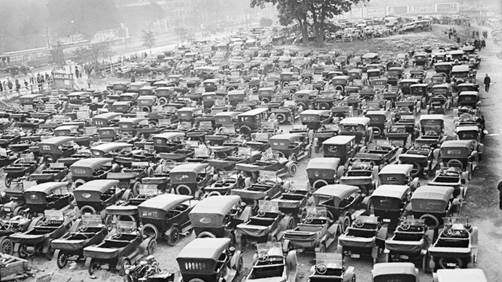
Although cars have changed a lot, the results of the games were amazingly the same.
In 1916, the Red Sox won Games 1 and 2 in Boston, lost Game 3 on the road and then won Games 4 and 5.
In 2018, the Red Sox won Games 1 and 2 in Boston, lost Game 3 on the road and then won Games 4 and 5.

Game 1: The best known game from the 1916 Series was Game 2 which featured two left-handed starters. Each pitched a 14-inning complete game that ended with a 2-1 Boston victory. The Brooklyn pitcher was Sherry Smith, a journeyman who lost more games than he won in a 14-year career. The Sox pitcher was Babe Ruth who would become a Hall of Famer, but not for his pitching (although he was a superb pitcher).
The starters for Game 1 in 2018 were also two left-handers, Clayton Kershaw of the Dodgers (a sure Hall of Famer) and Chris Sale of Boston (one of the best MLB pitchers this decade). Each left the game with no outs in the 5th, some 10 innings short of the work of Sherry Smith and the Babe in 1916.
Yes, 1916 and 2018 are worlds apart in pitching strategy. A parade of relievers is now common even when a starter seems to be on a roll with a “quality start.” There is a new term for this – “bullpenning” – and Dodger manager Dave Roberts has been called one of the foremost practitioners of the art. In a spring training interview this year, he said “It’s certainly more matchup-based, and outside the starter, teams are counting outs more, so you can look at it as counting outs or ‘bullpenning.’ You look at last year. I know in the National League, teams across the board were carrying eight relievers for the most part, so that speaks to bullpenning.”
In Game 1, the Dodgers lost both ways. The starter Kershaw was not sharp and the relievers matched him. Ryan Madson came on in the 5th in relief of Kershaw, game tied at 3-3, two runners on. Madson allowed both to score. Three other relievers came in for the Dodgers and each one of them was charged with an earned run. The Red Sox won 8-4.
Game 2: Just before Game 2, Fenway sported a double rainbow.

The Red Sox got strong pitching from starter David Price (2 runs in 6 innings) and three relievers who each pitched a perfect inning. The other key was timely hitting by the Red Sox – all four runs scored after two were out. Final score 4-2. There was also a fielding gem that made for a great photo shot – Andrew Benintendi’s leap for a drive in front of the final standings for the regular season. Video here.

Game 3: The Series moved from Fenway to Dodgers Stadium, and the Dodgers now had the benefit of warmer weather and excited fans. Plus a stellar start from rookie Walker Buehler who pitched seven shutout innings (the longest shutout stint for a rookie since Yorlando Ventura for the Royals in 2014). The only scoring in the first nine innings was a solo homer for each team. The Dodgers’ Cody Bellinger was bad and then good. He was picked off first in the bottom of the 9th to blunt a potential rally, but then in the top of the 10th made what might have been the best defensive play of the Series – throwing out Ian Kinsler at the plate after a catch in center field.
The score remained at 1-1 until the 13th when each team scored an unearned run to make it 2-2. Finally, in the 18th, Max Muncy hit a walk-off homer to give the Dodgers a 3-2 victory. Each team had used nine pitchers (compulsory bullpenning with 18 innings) and 23 of the 25 players on the roster.
It was the longest game in World Series history, in both innings (18) and duration (7:20). The previous inning record was 14, first set in the 1916 Series between these same two teams. It was later tied two times: in 2005, Astros v. White Sox, and in 2015, Royals v. Mets. The longest by the clock was that Astros/White Sox game in 2005 (5:41). It is fair to say the prior records were decimated.
Full disclosure: I went to sleep before the end of the game.
Game 4: The ceremonial first pitch brought Kirk Gibson to the mound. He of course hit the famous walk-off homer in Game 1 of the 1988 World Series, the last time the Dodgers won a Series. Gibson fidgeted on the mound for a while and then a relief pitcher was brought in – Dennis Eckersley, the Oakland pitcher who threw that home run ball to Gibson. Gibson then took his position behind home plate to catch Eckersley’s first pitch.
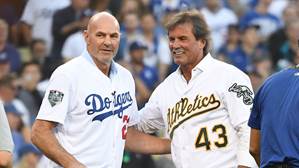
The Dodgers’ Rich Hill pitched a one-hit shutout through six innings. The Dodgers grabbed a 4-0 lead after Yasiel Puig hit a 3-run homer in the 6th. At this stage, the Dodger fans and certainly Puig sensed a victory that would tie the Series at two games each. The mood is captured in this video showing Puig’s bat flip and pitcher Eduardo Rodriguez’s glove throw.
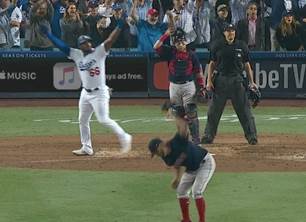
But the celebration was premature. In the 7th, Rich Hill was still working his one-hitter when he walked the first batter. Enter bullpenning. Hill was pulled and the six Dodger pitchers who followed him each gave up at least one run. The Red Sox scored nine times in three innings to go ahead 9-4. Most of the damage was done by Steve Pearce who homered in the 8th and knocked in three with a bases-clearing double in the 9th.
The Red Sox brought in their closer Craig Kimbrel for the bottom of the 9th. Nothing comes easy. He gave up a 2-run homer to move the score to 9-6. With one out, the dangerous Justin Turner came to the plate. I am telling this so I can quote from a tweet that came in about then: “Kimbrel vs. Turner is like an Amish street fight.” For those not familiar with these two bearded players, take a look:
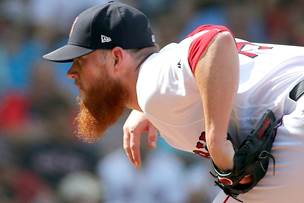
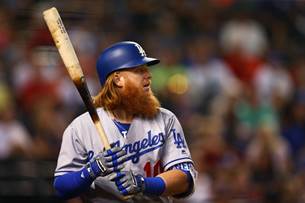
The top photo is Kimbrel who is also known for his unusual stance as he prepares to pitch (Jason Gay of the WSJ calls it a “pterodactyl’s wind-up”). In the Amish street fight, Turner won a minor victory by hitting a single. But that was it as Kimbrel got the next two batters and Boston was now up three games to one.
This being a come-from-behind victory for Boston over L.A., some MLB pundit found a Celtics/Lakers parallel with Pierce and Pearce.
2008 NBA Finals Game 4: Boston overcomes 24 point deficit to beat L.A. Paul Pierce leads team in scoring.
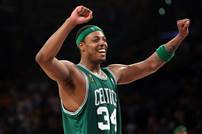
2018 World Series Game 4: Boston overcomes 4 run deficit to beat L.A. Steve Pearce leads team in RBIs.

Game 5: As if on cue, the Celtics and Lakers were back for Game 5. The opening promo was an entertaining exchange of trash talk between L.A.’s Magic Johnson and Boston’s Larry Bird. See the video here.
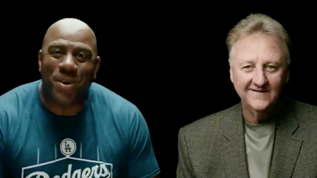
Game 5 matched two pitchers who have been mostly unsuccessful in postseason history. Clayton Kershaw had continued that narrative with a loss in Game 1. David Price got some redemption by winning Game 2. As for the offense, the main concern for the Sox was that Mookie Betts and J. R. Martinez had been hitless in Los Angeles.
In the first inning, Steve Pearce continued his hot streak with a 2-run homer. The Dodgers got a solo shot in the first to make it 2-1. The pitchers settled in and there was no more scoring until the 6th. Then Mookie Betts struck with a homer to make it 3-1. Dodger manager Dave Roberts resisted bullpenning and stuck with Kershaw. After all, the bigger problem was that the Dodger hitters were not providing any run support. In the 7th, J. D. Martinez hit a homer to increase the Red Sox lead to 4-1.
Pedro Baez relieved Kershaw in the 8th and gave up a homer to (who else?) Steve Pearce, his second of the game. That made it 5-1 which was the final score, and the Red Sox were World Champions.
The headlines from the 1916 Series seem prophetic for 2018:

The article shows that the 1916 winning share for each Red Sox player was $3,759. Inflation adjusted, that would be about $87,000. The numbers are not yet available for 2018, but the winning Astros in 2017 each took home $438,901.
Steve Pearce was named the 2018 World Series MVP. His .333 average, 3 homers and 8 RBIs certainly made him worthy. I would have voted to name David Price as the co-MVP. He was the winning starter in Game 2 and won Game 5 on short rest. He even stepped in for two outs during the 18 innings of Game 3. His ERA was 1.98. Clearly the pitching star of the Series.
One of the high points of the post-game festivities came from Alex Cora who is in his first year as Red Sox manager. He said he was going to ask ownership if he could take the trophy to his island home – his native Puerto Rico. Cora signed with the Sox on October 22 last year, just weeks after Hurricane Maria had devastated the island. His contract had a unique stipulation: the Sox would provide a planeload of relief supplies. In January, Red Sox players and officials and Boston’s mayor went to Puerto Rico as part of the relief effort. The Red Sox have many new fans in Puerto Rico.
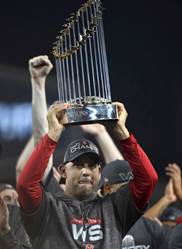
The true Hot Stove season now begins. Click here for the spring training countdown clock.
Lonnie’s Jukebox – Lin-Manuel Miranda: When Alex Cora takes the World Series trophy to show to his fellow Puerto Ricans, he may run into Lin-Manuel Miranda, the creator of Broadway’s Hamilton. Miranda’s parents are natives of Puerto Rico, and he has been instrumental in raising funds for the hurricane relief effort. That has helped with basic needs, but he also wants to nurture arts on the island. And he is making a grand gesture for that – he is reprising his title role in Hamilton for three weeks in San Juan this coming January. In his words:
“Nothing prepared you for seeing Puerto Rico in the aftermath of Maria. It’s important that we continue to support artists on the island who are making life for everyone around them better…It’s important to raise money for both the basics and the arts. I believe the arts help us survive; I believe music helps us on our hardest days. Arts provide release and catharsis and escape.”
As Hot Stove readers know, Rita and I cannot gush enough about Hamilton and Lin-Manuel Miranda. So here’s some more. Miranda is also a prolific tweeter who often starts the day with a “Gmorning” message and later in the day connects it with a “Gnight” message. He has collected many of these in a new book that is racing up the best seller lists.
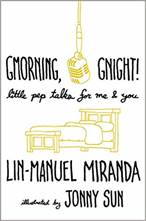
Last week, Rita gave me a heads-up on two new tweets from Lin-Manuel’s Twitter feed:
Gmorning
From the music you loved when you were 15
That helped you put a name to that abundance of feeling inside you
Still there for you, an old friend who remembers you and remains
Ready for a spin when you are
Gnight
From the song you loved when you were 15
That made you hit rewind until you knew every word and made it your own
Still there for you, an old friend who remembers you and remains
“Play me again, remember who you were, marvel at who you are,” it whispers
Damn he’s good. On Broadway and in the Twitter universe. And no doubt this December when he plays Jack in Mary Poppins Returns (Trailer here).
This of course prompted me to check out my 45-rpm records that I bought during my sophomore year in high school (1956-57). When Lin’s tweet says “Still there for you,” he means in your memory, but I can also take it literally because I still have those records. I opened up my record cases this past weekend and played some of the hits for my 15-year-old self. They were “ready for a spin when you are” and they sounded great, even with the hisses, pops and crackles from so many spins years ago. Each definitely “an old friend who remembers you and remains.”
I started my playlist with two records that hit the charts in August of 1956, the month I turned 15 – “Honky Tonk” by Bill Doggett and “Don’t Be Cruel” by Elvis Presley. Then I moved into the school year: “Blueberry Hill” and “Blue Monday” by Fats Domino, “Come Go With Me” by the Dell-Vikings, “Party Doll” by Buddy Knox, “Little Darlin’” by The Diamonds, I’m Walkin’” by Fats Domino, “Searchin’” by the Coasters, “Bye Bye Love” by the Everly Brothers and “A Teenager’s Romance” by Ricky Nelson.
These are chronicled in some detail from #10 to #20 in the original Lonnie’s Jukebox (click here). When I try to pick one song, it’s quite difficult. But I consulted my high school (and still) best of friends Diana and Shirley, and we agreed that it has to be “Party Doll” by Buddy Knox. [Buddy Trivia: Buddy Holly’s first hit “That’ll Be the Day” with the Crickets came out the following summer, debuting on August 12, three days after I turned 16.]
Diana and Shirley also agreed on the second best – “Honky Tonk” – because it was our favorite for dancing the “West Coast” at Teen Town. Below, my record player with “Party Doll” on the turntable and “Honky Tonk” next up. Listen to these two here and here.
